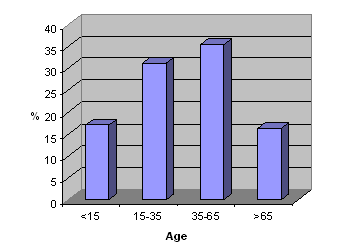Population density and structure
Population density is an indicator closely related with the level of human pressure to natural resources. Population density is defined as the ratio between (total) population and surface (land) area. This ratio can be calculated for any territorial unit, for any point in time, depending on the source of the population data. An alternative definition for population density is the number of persons per unit of area (which may include or exclude cultivated or potentially productive area). Commonly this may be calculated for a country, city, another territory, or the entire world. The following equation was used for calculation of population density:
![]()
Based on the data available for the area of Crete, the average population density is relatively low, 67.5 people/kmē, for the whole island, except for the large cities (Chania, Heraklion) in which population density is high (greater than 4200 people km-2). Population density of course increase substantially (4-5 times greater) during summer period due to large number of tourists arriving in the island. Even though the population density is not high in Crete, over-exploitation of the natural resources has been recorded in the last four decades by expanding agricultural land in natural areas by deforestation, increasing irrigated area in the olive groves, over-exploitation of water resources, and overgrazing rangeland.
Concerning structure of the population, 50.6% of the population are males and 49.4% females. The general data shows that the age distribution is almost the same for the ages >65 and <15 years (16.3% and 17.0%, respectively) (Fig 29). The other two classes of ages 15-35, and 35-65 years represent 31.2% and 35.5% of the total population, respectively. Population age is related to the distribution in rural and urban areas. Population of the rural areas working in the primary sector, consists of elder people as well which is a fact with various advantages or disadvantages such as lack of knowledge of new practices, old fashioned way of cultivating the land, lack of information on recent developments, etc.
Figure 30: Population age distribution for the island of Crete
